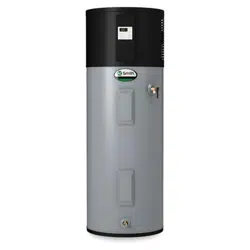Loading ...
Loading ...
Loading ...

TROUBLESHOOTING
22 • Residen al Hybrid Electric Heat Pump Water Heater Use and Care Guide
PROBLEM POSSIBLE CAUSE(S) CORRECTIVE ACTION
NO HOT WATER 1. No power to the water heater (No
lights on the unit are on).
2. Unit in Vacation mode
3. ECO open
4. Hot water usage pattern exceeds the
capability of the water heater in cur-
rent mode
5. Non-functioning upper temperature
sensor
6. Faulty thermostatic mixing valve.
7. Leak in plumbing system
1. Check for blown fuse or tripped breaker.
Restore power to unit.
2. Press Mode/Enter button and return to
desired operating mode.
3. Reset the high temperature limit switch; see
“Safety shut-off” section for more informa-
tion.
4. Change to different mode or modify usage
patterns.
5. Contact a qualified person for service.
6. Check hot water at other faucets.
7. Check hot water side of home’s plumbing
system for leaks.
INSUFFICIENT HOT WATER/
SLOW HOT WATER RECOVERY
(page 25)
1. Temperature set-point too low
2. Air filter dirty
3. Hot water usage pattern exceeds the
capability of the water heater in cur-
rent mode
4. Water connections to unit reversed
5. Heat lost through long run of exposed
pipe
6. Hot water leak at faucet or piping
7. Non-functioning heating element
8. Sediment or scale build up in tank
9. Incorrectly installed outlet j-tube.
10. Thermostatic mixing valve faulty/set
too low.
11. Low supply voltage.
1. Increase set point temperature; see
“Adjusting the Temperature” section on
page 16.
2. Clean air filter
3. Change to different mode or modify usage
patterns (For example if in Efficiency Mode
switch to Hybrid Mode)
4. Ensure the cold connection is at the bottom
and that the hot connection is at the top
5. Insulate exposed piping
6. Repair hot water leaks
7. Call qualified person for service
8. Drain and flush tank. Water conditioning
may be necessary to minimize build up
9. Check orientation of alignment mark with
arrow, re-install if necessary.
10. Check hot water at other faucets.
11. Check power (voltage).
TEMPERATURE TOO HIGH
(page 25)
1. Non functioning thermostat.
2. Grounded/shorted heating element.
3. Thermostatic mixing valve faulty.
1. Replace thermostat.
2. Replace heating element.
3. Check hot water at other faucets.
LOW WATER PRESSURE
(page 25)
1. Partially closed supply valve 1. Open supply valve completely.
WATER ODOR
(page 24)
1. A concentration of sulfate in the sup-
ply water
2. Little or no disolved oxygen in the
water
3. A sulfate reducing bacteria which has
accumulated within the water heater
(this harmless bacteria is nontoxic to
humans).
4. An excess of active hydrogen in the
tank. This is caused by the corrosion-
protective action of the anode.
1. Replace anode.
SOUNDS
(page 24)
1. Normal expansion and contraction of
metal parts during periods of heat-up
and cool-down.
2. Sediment buildup on or around the
elements.
3. The heat pump compressor or fan
running.
1. No action required.
2. Drain and flush the tank as directed under
the “Draining and Flushing” section.
3. No action required.
TROUBLESHOOTING CHART
Loading ...
Loading ...
Loading ...
